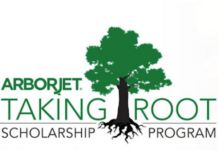
The browntail moth has recently made a strong resurgence across the Northeast, according to sources at Arborjet | Ecologel. Experts predict this will be a bad year for the invasive insect, “possibly the worst it’s been in over 100 years.”
The browntail moth was accidentally introduced into Somerville, MA from Europe in the late 1800’s. By the 20th century, the insect had spread to all of the New England states, New Brunswick, and Nova Scotia. The Maine Forestry Department says that browntail moth populations are again building in Maine and in areas along the coastal northeast.
The larval stage (caterpillar) of this insect feeds on the foliage of hardwood trees and shrubs including: oak, shadbush, apple, cherry, beach plum, and rugosa rose. This causes reduction of growth and occasional mortality of trees and shrubs.
While feeding damage causes concern, the browntail moth’s primary impact on people results from contact with poisonous hairs produced by the caterpillars. Microscopic, toxic hairs break off the caterpillars and can be airborne or settle on surfaces. Sensitive individuals who encounter the hairs may develop a skin rash similar to poison ivy and/or have trouble breathing.
“Timely treatment is even more important with the browntail moth than most other leaf-feeding insects because of the risk to humans posed by contact with their hairs,” says Rob Gorden, director of Urban Forestry and Business Development for Arborjet. “Treatments can be done in the spring when caterpillar larvae become active, as leaf expansion occurs, beginning in May into early June.”
Gorden adds, “If infestations persist in your area, then treatment is recommended again in the early fall, when new caterpillars emerge from egg masses. This will significantly reduce the severity of infestation the following season.”
For more information, Gorden will be hosting a free webinar on leaf eating caterpillars this week: Wednesday, May 11, at 3 PM EST.
Another upcoming Arborjet webinar from Brian Walsh of Penn State Extension will cover what to expect from spotted lanternfly in 2022, including solutions, expansion, and test results. It will be held Wednesday, June 1, 2022, at 3:00 pm EST. For more information, click here.
Arborjet offers an environmentally responsible tree injection treatment, TREE-äge R10, to control the browntail moth populations for up to two years.











![[VIDEO] Dickies®: Discover Workwear That’s Anything But Uniform](https://turfmagazine.com/wp-content/uploads/2023/06/1647663814-4b1a2a7742790a9b1e97a3b963477850192e1d6a9dfba9b07214a77bae25d6e3-d-218x150.jpg)






























![[VIDEO] Dickies®: Discover Workwear That’s Anything But Uniform](https://turfmagazine.com/wp-content/uploads/2023/06/1647663814-4b1a2a7742790a9b1e97a3b963477850192e1d6a9dfba9b07214a77bae25d6e3-d-324x160.jpg)